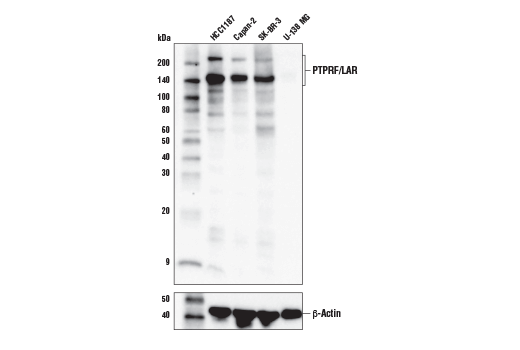WB
H
Endogenous
150, 213
Rabbit IgG
#P10586
5792
Product Information
Product Usage Information
| Application | Dilution |
|---|---|
| Western Blotting | 1:1000 |
Storage
Specificity / Sensitivity
Species Reactivity:
Human
Source / Purification
Monoclonal antibody is produced by immunizing animals with a synthetic peptide corresponding to residues near the amino terminus of human PTPRF/LAR protein.
Background
Receptor type protein tyrosine phosphatase F (PTPRF, LAR) is a transmembrane PTP that helps to regulate insulin signaling, cell proliferation and cell migration. The PTPRF protein is composed of an extracellular segment that contains several Ig-like and fibronectin (Fn-III) domains, a transmembrane region and a pair of cytoplasmic phosphatase domains (1,2). Functional studies reveal that the membrane-associated D1 phosphatase domain is responsible for substrate dephosphorylation, while the D2 domain is important for substrate specificity (3). PTPRF negatively regulates insulin signaling through dephosphorylation of insulin receptor and insulin receptor substrate (4). This phosphatase activates the pro-apoptotic DAPK serine/threonine kinase by removing a phosphate at Tyr491/492, while the kinase Src replaces the phosphate to inactivate DAPK at the same time it down regulates PTPRF expression (5). PTPRF is commonly found at focal adhesions where it interacts with liprin, which localizes the phosphatase to the membrane, and the Rac/Rho family GTPase Trio (6). Localization of PTPRF at adherens junctions results in PTPRF modification of β-catenin, which inhibits cell migration by limiting the amount of available cytosolic β-catenin (7).
- Cheng, A. et al. (2002) Eur J Biochem 269, 1050-9.
- O'Grady, P. et al. (1994) J Biol Chem 269, 25193-9.
- Tsujikawa, K. et al. (2001) Mol Endocrinol 15, 271-80.
- Zhang, W.R. et al. (1996) Mol Endocrinol 10, 575-84.
- Wang, W.J. et al. (2007) Mol Cell 27, 701-16.
- Stoker, A.W. (2005) J Endocrinol 185, 19-33.
- Müller, T. et al. (1999) J Biol Chem 274, 10173-83.
Species Reactivity
Species reactivity is determined by testing in at least one approved application (e.g., western blot).
Western Blot Buffer
IMPORTANT: For western blots, incubate membrane with diluted primary antibody in 5% w/v nonfat dry milk, 1X TBS, 0.1% Tween® 20 at 4°C with gentle shaking, overnight.
Applications Key
WB: Western Blotting
Cross-Reactivity Key
H: human M: mouse R: rat Hm: hamster Mk: monkey Vir: virus Mi: mink C: chicken Dm: D. melanogaster X: Xenopus Z: zebrafish B: bovine Dg: dog Pg: pig Sc: S. cerevisiae Ce: C. elegans Hr: horse GP: Guinea Pig Rab: rabbit All: all species expected
Trademarks and Patents
Limited Uses
Except as otherwise expressly agreed in a writing signed by a legally authorized representative of CST, the following terms apply to Products provided by CST, its affiliates or its distributors. Any Customer's terms and conditions that are in addition to, or different from, those contained herein, unless separately accepted in writing by a legally authorized representative of CST, are rejected and are of no force or effect.
Products are labeled with For Research Use Only or a similar labeling statement and have not been approved, cleared, or licensed by the FDA or other regulatory foreign or domestic entity, for any purpose. Customer shall not use any Product for any diagnostic or therapeutic purpose, or otherwise in any manner that conflicts with its labeling statement. Products sold or licensed by CST are provided for Customer as the end-user and solely for research and development uses. Any use of Product for diagnostic, prophylactic or therapeutic purposes, or any purchase of Product for resale (alone or as a component) or other commercial purpose, requires a separate license from CST. Customer shall (a) not sell, license, loan, donate or otherwise transfer or make available any Product to any third party, whether alone or in combination with other materials, or use the Products to manufacture any commercial products, (b) not copy, modify, reverse engineer, decompile, disassemble or otherwise attempt to discover the underlying structure or technology of the Products, or use the Products for the purpose of developing any products or services that would compete with CST products or services, (c) not alter or remove from the Products any trademarks, trade names, logos, patent or copyright notices or markings, (d) use the Products solely in accordance with CST Product Terms of Sale and any applicable documentation, and (e) comply with any license, terms of service or similar agreement with respect to any third party products or services used by Customer in connection with the Products.
